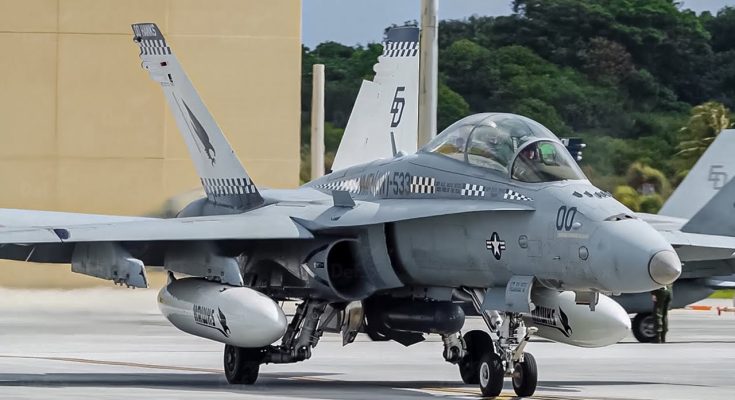The F/A-18 Hornet is one of the U.S. Navy’s most versatile and enduring aircraft, playing a critical role in both air superiority and ground attack missions. Known for its carrier-based operations, the Hornet is an integral part of the U.S. Navy’s air wing, operating from the decks of aircraft carriers and amphibious assault ships around the world. Its ability to perform a wide range of missions—from fighter combat air patrols (CAP) to close air support (CAS) and strike missions—makes it a cornerstone of the U.S. Navy’s power projection and global reach.
A Day in the Life of a Hornet at a Naval Base
At a U.S. Naval base, the F/A-18 Hornet is constantly being prepared for various operations. The aircraft, designed to be highly adaptable and capable of operating in a wide variety of environments, is used in both offensive and defensive roles. Whether the mission involves intercepting enemy aircraft, providing close air support for ground forces, or launching precision strikes on strategic targets, the Hornet is equipped to perform with outstanding precision.
Every day at a naval base begins with extensive preparation and maintenance for these multi-role jets. As the sun rises, aircraft maintenance crews and ground personnel are busy performing pre-flight checks and inspections to ensure the F/A-18 is ready for deployment. These checks include verifying the aircraft’s systems, weapons, and fuel levels, as well as ensuring its avionics and weaponry systems are fully functional.
The F/A-18’s adaptability is one of its most significant strengths. It can carry a wide range of air-to-air missiles like the AIM-120 AMRAAM, air-to-ground munitions like the GBU-12 Paveway II, and even electronic warfare systems for jamming enemy radar. This versatility means that the Hornet can quickly transition from one type of mission to another, depending on the tactical situation.
Launching from the Aircraft Carrier
The real spectacle of the F/A-18 Hornet’s capabilities is evident during takeoff from a nuclear-powered aircraft carrier. These massive ships, such as the USS Nimitz or USS Theodore Roosevelt, serve as mobile airfields, and the F/A-18 is the backbone of their flight operations. When a mission is called, the Hornet is quickly positioned on the flight deck, and after a final check by the launch crew, the jet is ready to be launched.
The jet blast deflector raises, and the catapult operator ensures that the aircraft is properly aligned. The Hornet is then rapidly accelerated along the runway by a steam-powered catapult, reaching takeoff speed in mere seconds. The power of the F/A-18’s twin engines propels the jet off the deck with such force that it appears to defy gravity. This quick launch is essential, especially in combat zones where time is critical.
Operating in the Sky
Once airborne, the F/A-18 Hornet performs a range of missions that can involve patrolling hostile airspace, engaging in dogfights with enemy aircraft, or executing precision bombing missions. The Hornet’s advanced radar and avionics systems give the pilot a comprehensive picture of the battlefield, enabling them to engage multiple targets simultaneously.
The versatility of the Hornet becomes even more apparent when it switches to close air support (CAS). In this role, the F/A-18 is invaluable to ground forces, providing critical air support during ground combat. Whether attacking enemy infantry, armored vehicles, or artillery, the F/A-18’s array of precision munitions allows it to deliver powerful strikes while minimizing collateral damage. The pilot’s communication with ground units ensures that the aircraft can deliver precise support based on real-time intelligence and changes in the tactical situation.
Recovery and Maintenance
After completing a mission, the F/A-18 Hornet returns to the carrier for recovery. Landing on an aircraft carrier is a delicate maneuver, requiring the pilot to catch a tailhook on the arrestor cables stretched across the deck to bring the aircraft to a rapid stop. The F/A-18’s tailhook design makes this possible, even with the aircraft’s high speed as it touches down.
Once safely on deck, the Hornet is rapidly rearmed, refueled, and prepared for the next mission. Naval aviation personnel on the flight deck work tirelessly, ensuring that the aircraft is ready for continuous operations. The Hornet’s durability and ability to undergo quick turnarounds mean that the Navy can maintain a high operational tempo, launching multiple sorties in a single day, each vital to mission success.
Conclusion: A True Multi-Role Fighter
The F/A-18 Hornet remains a testament to the flexibility and precision of modern naval aviation. Its ability to operate from aircraft carriers and perform a wide range of missions—from fighter air patrols to ground support and precision strikes—has made it a cornerstone of the U.S. Navy’s ability to project power globally. The dedication and coordination of the personnel working at naval bases ensure that these multi-role jets remain operational and ready to execute their mission at a moment’s notice, providing vital support to military operations worldwide. The F/A-18 Hornet is, without a doubt, one of the most effective and versatile aircraft in the skies today.



